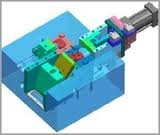TIPS FOR GOOD INJECTION MOLDING DESIGN

Creating a good injection molding design is more than just coming up with a way to build a plastic injection molding based on a part design.
There are many factors that can make or break a successful injection molding design and the knowledgeable designer should incorporate these basic rules of thumb in every job. At the very least, these tips provide a good starting point for a this critical part of the molding process.
- Resin choice. This decision is usually determined by the customer. However, a mold designer’s personal experience my enable him to offer practical suggestions that can improve the performance of the part. The molding process may also be improved by changing the resin.
- Surface finish requirements. Very often customers overlook the cost of higher surface finishes. Obviously, the more labor required to hand polish, EDM polish or texture the tool, the higher the cost. It may be possible to lower the finish requirements without affecting the part performance. This also can help with the molding process and save time and money.
- Uniform wall thickness. When the wall thickness of the part is incorrect, there are many problems that ensue. Among them are sink marks, warpage, stress marks, and other conditions that cause headaches for everyone involved. Often, a simple analysis of the wall thickness could have easily avoided these problems.
- Ratio of wall-to-rib thickness is commonly overlooked. A general rule-of-thumb is that the rib should be approximately one-half the wall thickness. Ignoring this rule leads to sink marks on the part.
- Placement and geometry of bosses is very important. When a boss is located in a corner, with two adjacent wall, care must be taken to minimize the variation of wall thickness. Additional coring and the correct placement of the connecting ribs will help reduce sink marks.
- Warpage is often the result of poorly planned wall thickness. Because thicker sections cool slower than thin ones, the plastic part tends to warp. The only way to avoid this is to change the design to have more uniform wall thickness.
- Ejector pin size and placement is crucial to a successful molding design project. Most injection molds use round ejector pins to eject the solidified plastic part from the mold during production. The pins should be strategically placed to minimize their effect on the part, yet be sufficient in size and quantity to eject the part without damaging or warping it.
- Radiused corners are essential for a good injection molding design. Sharp corners place stress on the part and hinder the flow of the molten plastic during the injection molding process.
- Drafted side walls enable the part to be ejected without damaging the surface finish. Typically, a minimum of 0.5 degrees is advised for a part side wall in the direction of pull. As long as the dimensional tolerances allow, add more draft. This will aid in the molding and mold making process. It also helps the mold polishing operation.
Conclusion
By following good injection molding design practice and using a checklist to avoid overlooking features, the mold designer’s job is helped to be a little less stressful and a lot more manageable.